.jpg) |
|
|
|
|
|
|
|
WELCOME
TO BAGHERIA
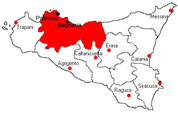 The
City The
City
by Giuseppe Francesco Fricano
The territory of Bagheria has an ancient history. The first
vestiges take us back to prehistoric times on the Monte
Porcara and at Pizzo Cannita,
as well as Phoenician and, later, Hellenistic-Roman
Solunto, and on over the aqueduct bridge over the
Eleuterio River in late Gothic
style to the Solanto barony.
From the latter there was born the town of “baroque
villas”, the crowning glory of the
Palermo aristocracy. The history of the cultural heritage
goes hand in hand with that of the agrarian landscape:
the forest, sugar cane, vineyards, tomatoes and lemons.
The recent history, in the century we have just left behind
us, is the vine and wine history of the Alliata
family, that of the big families linked to tomato
processing (Dragotta, Verdone…)
and lastly the history of the citrus fruit industry.
Bagheria is also a story of intellectuals and artists: F.
Scaduto, G. Cirrincione, I. Buttitta, R. Guttuso, F. Scianna,
G. Tornatore, and D. Maraini.
Today, Bagheria is a town of service industries, with a
population of just over 50,000. It is witnessing the decline
its lemon-growing, food end agriculture tradition, and is
trying to find its way into a future that cannot be reached
solely through building. People in the town are beginning
to realize that the time has come to appreciate what exists
naturally:
• They are gathering up the relics of their history,
reopening the villas and constructing a museum circuit;
• They are valorizing the coast and aiming at making
big environmental context available to the public;
• They are organizing events and proposing Bagheria
as a place of renewed artistic commitment.
These efforts comprise the Bagheria of the future, which
is already on the way, a way that is being pursued with
determination, and valor. Bagheria is already a
cultural gem on the eastern outskirts of the metropolis,
and is destined to be even more.
This town is rediscovering that artistic and cultural
identity that sees its imprint in the building
of villas, and the work of the priest Castronovo, and aims
at rediscovering a space in the higher educational system
in the metropolitan region of Palermo.
Bagheria is reviving the traditional welcome at the trattorias
where “caravans” sought refreshment after loading
wagons with lemons, and is broadening its accommodations
to meet modern needs.
It is preparing to receive all those who choose to spend
a holiday rich in stimuli there: these pages are addressed
to those people.
|
|
|
|
|
|
|
|
|
|
|
|
|
|
|
|
Historical
Itineraries
Passage to Picturesque
Villas and Enchanting Landscape
You can reach Bagheria along the coastal state road that connects
Palermo to Messina by way of a seemingly
interminable succession of bends. The outskirts of the capital
appear never-ending, infinitely extending into the outer
villages of the “metropolitan belt” which, by
now, have reached into every corner of the plains, sliding
off the blue-crested mountains, and sloping down toward the
bright emerald sea. Traveling through the territories of
Bagheria, you can sense that here the imagination of many
architects was allowed to run free: buildings with strange
shapes and unusual colors stand side by side with more traditional
ones of limestone, giving rise to a very picturesque whole.
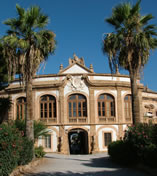 One perceives that there is something special in the air;
perhaps it was this same perception that inspired Ferdinando
Gravina, the Prince of Palagonia, and one of the
most celebrated personalities of Bagheria to date. The Prince,
who was certainly an exceptional character among the eighteenth-century
elite, designed the gloriously baroque Villa Palagonia,
also known as the “Villa of Monsters,”
which today remains the main attraction of the town. Upon
meeting with the prince, Goethe, the German poet and philosopher,
described Gravina as a “scrawny gentleman …a solemn
and grave old man, all spruced and powdered…,”
an old-fashioned nobleman, at least by appearance. However,
the prince, was quite different from his peers, so much so
that some have called him an ingenious precursor of surrealistic
art. His contemporaries, on the other hand, did not hesitate
to declare him insane: how else could they have defined a
man who filled his park with statues absolutely devoid of
grace-- deformed, monstrous figures-- in a word, ugly? As
if this were not enough, prince Ferdinando was notorious
for playing jokes on anyone who had the misfortune, or misjudgment,
to visit him: chair legs were often sawed off, making it
impossible to sit upright; in the case of those chairs left
whole, guests would occasionally find that the seat padding
hid a handful of terrible nails…
One perceives that there is something special in the air;
perhaps it was this same perception that inspired Ferdinando
Gravina, the Prince of Palagonia, and one of the
most celebrated personalities of Bagheria to date. The Prince,
who was certainly an exceptional character among the eighteenth-century
elite, designed the gloriously baroque Villa Palagonia,
also known as the “Villa of Monsters,”
which today remains the main attraction of the town. Upon
meeting with the prince, Goethe, the German poet and philosopher,
described Gravina as a “scrawny gentleman …a solemn
and grave old man, all spruced and powdered…,”
an old-fashioned nobleman, at least by appearance. However,
the prince, was quite different from his peers, so much so
that some have called him an ingenious precursor of surrealistic
art. His contemporaries, on the other hand, did not hesitate
to declare him insane: how else could they have defined a
man who filled his park with statues absolutely devoid of
grace-- deformed, monstrous figures-- in a word, ugly? As
if this were not enough, prince Ferdinando was notorious
for playing jokes on anyone who had the misfortune, or misjudgment,
to visit him: chair legs were often sawed off, making it
impossible to sit upright; in the case of those chairs left
whole, guests would occasionally find that the seat padding
hid a handful of terrible nails…
Upon arriving at Villa Palagonia, one notices the work of
the friar architect, Tommaso Maria Napoli,
in front of the main entrance. While the original design
was still intact, guests were received by statues depicting
two somber characters perched on thrones of stone, scrutinizing
them with imperturbable stone eyes: sixteen eyes to be precise,
as one of the statues had six eyes in its head, while the
other made use of the watch of two goats plus three heads
of his own—two of which also served as his hair! Inside
the villa one can still visit the original vestibule, frescoed
with images from Greek mythology’s The Toils of Hercules,
as well as the so-called “Mirror room,” where
the walls and ceiling are embellished with fancy patterns
in masonry and lined with over twenty busts by various authors
and in varying styles—all this framed by countless
fragments of mirror placed at myriad angles, so as to multiply
the images infinitely.
However, it was Prince Giuseppe Branciforti,
a member of one of the oldest, most decorated, and much-heralded
families in Sicily, who had the honor of erecting the first
mansion in the area known today as Bagheria, giving rise
to the urban center of the town. The prince, embittered by
the failure of a conspiracy to take over Sicily’s then-vacant
throne (which concluded, instead, with the death of many
of his co-conspirators), as well as several deaths in his
family, decided to move his residence out of the city. In
1658, he built a small towered refuge, complete with merlons,
in the heart of the fertile valley east of Palermo, then
known as
“Bagaria.” He called
the mansion “Villa Butera,” and,
on the main door, facing Palermo, he inscribed the words:“O
Corte Addio,” or, “Farewell, Oh Court.”
From that point on, Branciforti refused to take any further
part in politics, preferring to live more solitarily, and
looking after his estate, instead. However, his entourage
included a large number of people who eventually settled
all around the princely mansion, which, in turn, became the
birthplace of yet another society, this time a small agricultural
village.
The prince’s new mansion consisted of a long central
hall, arrived at by means of two flights of steps, one at
either end of the rectangular structure. At the foot of each
grand stairway was a large courtyard, around which were the
servants’ quarters and the church. Over the rear entrance
loomed an extravagantly-framed bust of the founder. At one
time, the prince’s mansion was surrounded by a large
park.
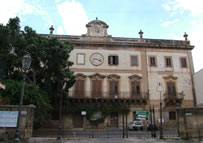 Not
far from Giuseppe Branciforti’s new settlement lies
the “Certosa,” or “Charter
House,” a small neoclassical building constructed in
1797, where a relative, Ercole Michele Branciforti, founded
one of the first wax museums in Europe. Here, well-known
personalities of the era were constructed entirely of wax,
and portrayed as Carthusian monks within their natural environment,
often accompanied by their servants.. For some time, the
quaint monastery was a destination for many visitors, who
were also attracted by the opportunity to admire part of
the Branciforti estate, as the prince had placed artwork
and furnishings of great value here, and had even commissioned
the Spanish baroque painter, Diego Velasquez, to fresco the walls.
There is currently an effort underway to reconstruct the wax
statues, sponsored by the Bagheria Council in cooperation
with Pietro Piraino, a researcher and expert on antique toys
and dolls, including wax figures. Not
far from Giuseppe Branciforti’s new settlement lies
the “Certosa,” or “Charter
House,” a small neoclassical building constructed in
1797, where a relative, Ercole Michele Branciforti, founded
one of the first wax museums in Europe. Here, well-known
personalities of the era were constructed entirely of wax,
and portrayed as Carthusian monks within their natural environment,
often accompanied by their servants.. For some time, the
quaint monastery was a destination for many visitors, who
were also attracted by the opportunity to admire part of
the Branciforti estate, as the prince had placed artwork
and furnishings of great value here, and had even commissioned
the Spanish baroque painter, Diego Velasquez, to fresco the walls.
There is currently an effort underway to reconstruct the wax
statues, sponsored by the Bagheria Council in cooperation
with Pietro Piraino, a researcher and expert on antique toys
and dolls, including wax figures.
At the steps of the Branciforti Villa begins a long avenue
drawn up in 1769 by another member of the family, Don Salvatore.
The avenue, known today as Corso Butera, intersects a second
street, Corso Umberto, thereby forming the center of today’s
urban development that is the Commune of Bagheria. Other
foundational aspects of the Commune were to follow: the prince
also commissioned the architects P. Vivaldi and S. Attinelli
to build the “Chiesa
Madre,” (cathedral church), a towering structure
of yellow stone that was completed in 1708, as well as a new
wing on his family’s ancestral mansion.
In the meantime, various aristocratic families had followed
the example of the Brancifortis and had summer residences
built in the desirable Bagheria area referred to as villas
of the “Piano Nobile,” or “Bagheria
plain.” Indeed, the position of the plain
was decidedly a favorable one: here you could get away from
the oppressive heat of the crowded roads and buildings in
the city and find a cooler temperature and fresher air among
the olive tree plantations, thanks to the pleasant breeze
of the sea.
One shining example of these famous Bagheria residences is
Villa Valguarnera, designed by the architect
Napoli. The villa was built over a period about seventy years
starting at the beginning of the eighteenth century, and was
one of the biggest and most sumptuous homes of all, with a
grand circular courtyard, a monumental flight of steps, fine
statues, and frescoes. Even today, Villa Valguarnera serves
as a private residence, and so, unfortunately, is not open
to visits by the public.
top
Returning
to the City of Villas
Following
the avenue of “historical villas” in
the town center, the visitor will discover many lesser-known
architectural jewels. Villa Trabia is private
property, and though you can only see two of the mansion’s
facades, people nevertheless go out of their way to catch
a glimpse of its unique, two-color scheme. Also worth noting
is park that surrounds the villa, in the neoclassical style. Villa Villarosa, completed at the end of
the eighteenth century and attributed to the architect, Venanzio
Marvuglia, can be visited by contacting the local
entertainment committee (Pro Loco). The elevated villa is
worth seeing for its grand staircase alone, leading to a portico
famous for its series of eight Corinthian-style columns. Villa
Ramacca, known for its adornment in maiolica ceramics,
is situated in a splendid panoramic position within a lush
garden of exotic 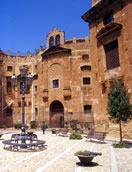 plants.
At Villa San Cataldo, built by the royal
Galletti family of San Cataldo at the beginning of the seventeenth
century, one can visit the incredible extensive gardens typical
to that period of Sicily - this villa’s layout can
be traced back to the foundation of the villa, along with
a small family church and several inner courtyards. The villa
was restructured in the nineteenth century in a neo-Gothic
style, complete with corner towers, and today belongs to
the Province of Palermo. plants.
At Villa San Cataldo, built by the royal
Galletti family of San Cataldo at the beginning of the seventeenth
century, one can visit the incredible extensive gardens typical
to that period of Sicily - this villa’s layout can
be traced back to the foundation of the villa, along with
a small family church and several inner courtyards. The villa
was restructured in the nineteenth century in a neo-Gothic
style, complete with corner towers, and today belongs to
the Province of Palermo.
You can access the Villa Larderia, which
currently houses a religious institute, by contacting the
sisters who run the villa beforehand. There one can admire
not only the villa itself, but also one other unique attraction—the
rare and radiant stellar plant, not to be found in any other
villas in the Palermo area. Unfortunately, the building is
incomplete: it is missing an access step, a characteristic
element of most Bagheria buildings.
Much like one of the wings of Palazzo Butera,
the cathedral church of Bagheria was built through the initiative
of one of the Princes of Butera, Salvatore Branciforti. The
church had been open to the public since 1708, however, due
to increased population, the cathedral proved inadequate
after just a few decades. The new church was completed in
1777. The great square in front of it is now Piazza Vittorio
Emanuele, which also marks the beginning of Corso Umberto
I, the second most important street in the town The rebuilt
church has a simple façade, adorned with pillars and
columns. It was built using tufaceous stone from the nearby
quarries, or pirrieri, at Aspra.
Curiously, there are no side aisles in the cathedral church
at the palazzo. There are, however, various intriguing works
of art, such as a wooden crucifix by Bagnasco
and an eighteenth-century statue of the Madonna. There is
also an impressive early twentieth-century fresco by the painter,
De Simone, depicting Moses and the Consignment
of the Table of Law, touching all four walls.
Follow the lively Corso Umberto and turn left to reach the
Piazzetta San Sepolcro, home of a church of the same name,
built in the first half of the eighteenth century, with renovations
in 1866 and 1984. The present- day façade, made of
Billiemi marble in neo-Gothic style, was finished in the
early twentieth century. The interior of the church is decorated
with eighteenth-century works of art, including the Grieving
Virgin by Quattrocchi, and a depiction of
the Passion of Jesus on the ceiling. The high, baroque-style
marble altar serves as its centerpiece.
The building of Anime Sante church also
dates from the eighteenth century. It was built on the spot
where the Purgatorio church stood previously, in the square
of the same name. The façade of Anime Sante, completed
at the start of the twentieth-century, is in the neo-Norman
style with three arched doorways. There is a large nave,
with a ceiling frescoed by Bagheria painter, Onofrio Tomaselli,
and two small side aisles. On the high altar there is a beautiful
wooden statue of the Immaculate Virgin, much-revered by the
citizens of Bagheria.
Among eighteenth-century buildings one should also take note
of the Arch of the Most Holy Trinity (also
known as the Arch of the Eternal Father), as well as the original
entrance to Villa Palagonia. Often overlooked,
these structures are actually urban models of major historical
interest. Note the defense towers from the sixteenth and seventeenth
centuries, as well as the farms in the surrounding area, some
of which are still operational. |
|
|
|
|
|
|
|
|
|
|
|
|
|
|
|
Museums:
pathways of memory
By contrast, one can explore Villa
Aragona Cuto’,
designed by the friar architect Giuseppe Mariani.
Villa Cuto’  is
now council property that houses, among other offices, the
central library of Bagheria. Aragona Cuto’ is a massive structure
that also serves as a base for a large outdoor gallery, complete
with inlaid marble designs along a wide promenade, and providing
incredible views of a vast panorama that reaches as far as Palermo.
In fact, from here the Prince of Cuto’ was known to play
host to guests as they took in the fireworks that were lit in
the gulf of Palermo for the “Festino of Santa Rosalia.”
Villa Aragona Cuto’ is special among
the many elegant holiday homes that the Palermo aristocracy
built in the eighteenth century in the Bagheria area. The structure
is different from that of other country villas, more closely
resembling that of city mansions. One example of this is the
fact that the villa is actually u-shaped, with a large courtyard,
or “cortile,” that is accessed through an archway.
The access staircase to the house, itself, is inside the courtyard.
Other important details are the rich frescoes of the salon walls,
which were a strong trend in the eighteenth century aristocratic
homes. Today, the stately salon of the Villa Cuto’ is
also the home of a collection of antique toys belonging to Pietro
Piraino, the Palermo restorative artist and wax modeler. is
now council property that houses, among other offices, the
central library of Bagheria. Aragona Cuto’ is a massive structure
that also serves as a base for a large outdoor gallery, complete
with inlaid marble designs along a wide promenade, and providing
incredible views of a vast panorama that reaches as far as Palermo.
In fact, from here the Prince of Cuto’ was known to play
host to guests as they took in the fireworks that were lit in
the gulf of Palermo for the “Festino of Santa Rosalia.”
Villa Aragona Cuto’ is special among
the many elegant holiday homes that the Palermo aristocracy
built in the eighteenth century in the Bagheria area. The structure
is different from that of other country villas, more closely
resembling that of city mansions. One example of this is the
fact that the villa is actually u-shaped, with a large courtyard,
or “cortile,” that is accessed through an archway.
The access staircase to the house, itself, is inside the courtyard.
Other important details are the rich frescoes of the salon walls,
which were a strong trend in the eighteenth century aristocratic
homes. Today, the stately salon of the Villa Cuto’ is
also the home of a collection of antique toys belonging to Pietro
Piraino, the Palermo restorative artist and wax modeler.
The
Toy and Waxworks Museum
The Toy and Waxworks Museum, housed within
the Villa Cuto’, boasts a collection of hundreds of
pieces from many different eras and on many different themes:
tools, small trains and automata, bells, dolls and tiny sets
of saucepans, to name a few. In the first room we find delightful
nativity scenes and models of the Baby Jesus in wax; some
of these even go back to the eighteenth century, modeled
according to the ceroplastic tradition, now a nearly lost
art. There is also a space adjoining the museum where Pietro
Piraino, himself, set up a small workshop for restoring toys,
wax objects, cribs and other related paraphernalia.
Villa
Cattolica Renato Guttuso Museum
 Thanks
to a generous donation of works by the artist, Renato
Guttuso, the rooms at the eighteenth century Villa
Cattolica are now home to a Municipal Gallery.
Villa Cattolica, a curved, three-story structure surrounded
by palm trees, does not only display work by Guttuso
(including outdoor sculptures), but it also serves as
a gallery and exhibition space for other important contemporary
artists. One should further note that Guttuso’s
remains rest in a monumental sarcophagus created by the
sculptor, Giacomo Manzu’,
in the main garden of the villa. Thanks
to a generous donation of works by the artist, Renato
Guttuso, the rooms at the eighteenth century Villa
Cattolica are now home to a Municipal Gallery.
Villa Cattolica, a curved, three-story structure surrounded
by palm trees, does not only display work by Guttuso
(including outdoor sculptures), but it also serves as
a gallery and exhibition space for other important contemporary
artists. One should further note that Guttuso’s
remains rest in a monumental sarcophagus created by the
sculptor, Giacomo Manzu’,
in the main garden of the villa.
Museum
of Cinematographic Art
from the Marx Brothers to Federico Fellini
Recently, a significant portion of the gallery at Villa Cattolica
has been dedicated to the development of an exhibit
on cinematographic art. Posters associated
with early modern films are featured prominently, with
a large selection of movie-posters that range from 1927
through 1984. The exhibit was developed in large part
due to the generosity of the Lo Medico brothers, descendants
of a Bagheria family of cinema managers. The Lo Medicos
donated an extensive collection of film posters to the
town, including ones for well-known titles such as “Federico Fellini’s
“Roma,” and “A night in Casablanca ”
by the Marx brothers. A poster for ‘Manon
Lescaut,” a film that dates from 1928, when the cinema
was still silent, is also included, as well as a poster
for the film, “La Wally”,
which happened to be the first movie with sound ever to
be projected in Bagheria. It is difficult to overstate
the importance of these posters, or the impact they had
on the cinematographic community, since, at one time, they
were the only methods of advertisement for films. Moreover,
one learns that the drawings and photographs used to depict
the movies were often entrusted to major artists, which
not only adds to their great monetary value, but explains
their particular beauty, as well.
The Sicilian Wagon Museum
Pictoral Art in Movement
Finally, in the outbuildings of the villa Cattolica, in a
section that, until a few decades ago, was used as a post
office, curators are currently setting up a Wagon
Museum. Here one will explore the history, construction,
and decoration of this very traditional Sicilian means of
transportation. The wagon-- a large, decorative, animal-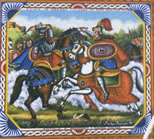 drawn
cart of solid wood, has been the subject of many studies and
tributes by various illustrious Bagheria citizens, and was
even the subject of director Giuseppe Tornatore’s
first short film, Il Carretto. drawn
cart of solid wood, has been the subject of many studies and
tributes by various illustrious Bagheria citizens, and was
even the subject of director Giuseppe Tornatore’s
first short film, Il Carretto.
Despite the commune’s prominence in historical and cultural
affairs, there were no asphalted roads in Bagheria until 1939.
As a result, the wagon was the only means of transport. In
fact, in 1934, the town had no fewer then twenty-five fully
active carriage-makers’ workshops. Carpenters used
walnut, beech or seasoned ash to build the wagons, which
were later expertly carved and painted with resistant colors
and linseed oil. On the sides, or masciddara, the painters depicted
historical, spiritual, and fantastical images, including parables
from the Old testament, the life of Jesus Christ, the
Paladins of France, Orlando Furioso (an Italian medieval
epic poem consisting of 46 cantos), Christopher Columbus,
the Three Musketeers, events from Roman history, themes of
famous operas, and hunting scenes. The greater or lesser
degree of decoration of the wagon was an indication of prestige
that reflected upon the owner. Some wagons were so grandly
decorative, using techniques so laborious and precise that
the artist, Renato Guttuso, once remarked
that “The art of painting the wagon revealed a natural
artistic sense that went beyond the sphere of craft and belonged
to the reasons of painting”. |
|
|
|
|
|
|
|
|
|
|
|
|
|
|
|
Events
Feasts and Traditions
St. Joseph, Patron Saint of Bagheria
Not only can you see and taste them, but you can dip into
the colors and flavors of the town’s past during
the feast of the patron saint, St. Joseph. The festival
of St.
Joseph is currently held during the first
week of August, a date that was chosen in order
to allow Sicilian emigrants in other parts of the world to
return and take part in the historical and folk memories
of the town. Amid the sounds of the “tammurinara”(drummers),
and the colors of nougat and nut stands (turrunara and caliara),
the folklore of Sicilian carts and the carters’ songs
fill the streets of the town. The joy and excitement of the
experience is like breathing magic air, as layers of history
and past cultures arouse intense emotions in the visitor.
The event culminates in a sensational fireworks display.
The actual feast of St. Joseph falls on the 19th of
March. On that day, the town inevitably comes to
a standstill as residents assist in the procession of the
simulacrum. There is also large wood bonfire on the eve of
the procession. The celebration of St. Joseph is a manifestation
of the anthropological phenomenon of the contradictions of
man, perpetually poised between the sacred and the esoteric,
befitting an ancestral culture. Not to mention the prominence
of gastronomy in these celebratory events, where the traditional
Sicilian sweets known as sfince, soft pockets of fried pastry
stuffed with sweet ricotta cheese and chocolate bits and topped
with candied fruit, are a main attraction.
Bagheria
in America
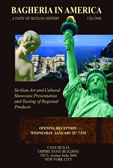 You
are welcome to enjoy a spectacle of arts coming from a city
of ancient history... You
are welcome to enjoy a spectacle of arts coming from a city
of ancient history...
Beautiful Villas immersed in a lush territory of citrus gardens
facing the generous blue sea of Sicily. Experience the fruits
of our land with all of your senses...
St.
Peter, San Antonio
Celebrations in June
Summer
in Bagheria/Estate Bagherese
15 June/30 September
Culture, folklore, sport and music
Christmas
Various events
Easter
Various events |
|
|
|
|
|
|
|
|
|
|
|
|
|
|
|
Sicilian
Gastronomy
Bagheria
is to be enjoyed not only through seeing, but with all of the
senses, particularly smell and taste, as the town has a vast
array of gastronomic delights to offer its visitors.Walking
along the town’s side streets,  you
come across many old taverns, or trattorie, their framework
infused with the scent of meat and old barrels; fried food stands
coffee bars; and gelato shops you
come across many old taverns, or trattorie, their framework
infused with the scent of meat and old barrels; fried food stands
coffee bars; and gelato shops
Nature’s flavors combine in harmony with Sicilian traditions
of blending cultures and crafts, the end result being a cuisine
all their own, influenced by Arab, Norman and Spanish
techniques and ingredients.
Bread rolls with “panelle” (chickpea
fritters); focaccia stuffed with ricotta cheese; eggplant
parmigiana (a dish that many are surprised to learn
is Sicilian by origin) “arancine”
(crispy fried rice balls); pasta with sardines; roasted cauliflower
with pasta; roast lamb and pork sausage; “braciole,”
(meat stuffed with nuts and raisins); salted anchovies
and other fresh fish from the Aspran waters...
Desserts are equally as tempting, with the “cassata,”
a traditional Sicilian cake layered with sweetened, chocolate-studded
ricotta, marzipan, and candied fruit taking central importance
within a large collection of sweets. Crispy cannoli
filled with ricotta-based cream and topped with pistachio, sfinge
and other fried pastries, pistachio and lemon gelato churned
in the rustic artisan manner, and various fruit and almond-based
confections round out a list of sweet delicacies typical to
the region. And these are just a few examples of the diverse
and exciting Sicilian culinary tradition. Sicilian cuisine,
like so many aspects of our culture, represents the historical,
cultural, artistic and architectural evolution that the various
explorers, conquerors, and developers gave our people. |
|
|
|
|
|
|
|
|
|
|
|
|
|
|
|
Restaurants
Alla corte di Don Giuseppe di Chiarello
via Farina, 8 tel. 091 96 91 76
Aries
Ristorante
via Dante, 69
tel. 091 96 56 88
Il
Barone di Munchausen
di Pintacuda Sergio & c.
via Pintacuda, 47
tel. 091 90 04 30
Il
Melograno
via. B. Mattarella, 142
tel. 091 90 24 31
I
Malavoglia
Corso Butera, 9
tel. 091 90 91 72
Trattorie
Antica Trattoria Al Carretto di Martorana
F.sco
via Papa Giovanni XXIII, 170 tel. 091 90 28 85
Al
Baglio
via del Cavaliere
tel. 091 90 13 91
Da
Giovanni il Conte
via Filippo Buttitta, 40
tel. 091 96 27 29
Don
Ciccio del figlio Santo
Via del Cavaliere, 87
tel. 091 93 24 42
Trattoria
del Conte
via Federico II, 48
tel. 091 93 17 12
Trattoria
da Melchiorre
figlio di Don Ciccio
Contrada Consona
tel. 091 93 40 93
Trattoria
Zzà Maria
via Paternò, 11
tel. 091 93 13 88
Trattoria
Don Ciccio
di Buttitta Giuseppe
via Stazione, 8
tel. 091 93 43 66
Pizzerias
Focacceria di Buttitta Mimmo
via De Spuches, 34
tel. 091 90 31 24
Antica
Focacceria Chiello
fondata nel 1856
Piazza Sepolcro, 18
Litomil
Pivo srl
di Lo Galbo Donatella
via B. Mattarella, 62
tel. 091 90 24 41
Matahari
Bistrot srl
via Dante, 56
tel. 091 96 15 19
Mineo's
Pizza House
via G.F. Malipiero, 6
tel. 091 96 43 69
Discotheque
Villa Cavaretta
Ss. 113 Km 249
tel. 091 96 20 02
Theatres
/ Cinemas
Excelsior
Via C. Scianna, 34
tel. 091 90 29 45
Capitol
via Roma, 8
tel. 091 93 19 35
Supercinema
Multisala
via Carà, 186
tel. 091 96 95 78
Museums,
Villas and Art Galleries
Villa
Cattolica. Civica Galleria d'Arte Moderna e Contemporanea "Renato
Guttuso"
SS 113 Km 248
tel. 091 90 54 38 - 94 33 52
Museum
di Ezio Pagano
via Città di Palermo, 158
tel. 091 90 39 71
Bottega
delle Arti
via Consolare, 177
tel. 091 90 45 55
|
|
|
|
|
|
|
|
|
|
|
|
|
|
|
|
Nature's
Riches and Antique Custom
ASPRA
“a window
on the sea”
The wealth of Bagheria is not limited to history and monuments,
but lives on in the landscape. Natural treasures include the
picturesque valley of the river Eleuterio; the park of Monte
Catalano with its caverns,  tunnels,
and 26 wild varieties of orchid; and the lively seaside village
of Aspra, known for its breathtaking beaches and cliffs which
serve as an enchanting backdrop for locals and tourist alike.
To the residents of Bagheria, Aspra is known as their “window
on the sea,” and is the location of the annual sea feast,
also known as the feast of the “Grieving Virgin,”
held there in September of each year, a perfect example of
the unmistakable bond between island natives and the water
that surrounds them. tunnels,
and 26 wild varieties of orchid; and the lively seaside village
of Aspra, known for its breathtaking beaches and cliffs which
serve as an enchanting backdrop for locals and tourist alike.
To the residents of Bagheria, Aspra is known as their “window
on the sea,” and is the location of the annual sea feast,
also known as the feast of the “Grieving Virgin,”
held there in September of each year, a perfect example of
the unmistakable bond between island natives and the water
that surrounds them.
The story of Aspra is inextricably linked to that of Bagheria.
Today, the economic development of our territory relies on
the support of numerous fish and conserve industries active
in the seaside area, which, beginning at the start of the
twentieth century, have both provided employment, and contributed
to the positive and hardworking image of our people. While
exploring Aspra, one should visit the church in Piazza Maggiore
Cipolla, which enjoys the distinction of frescoes painted
by internationally-renowned local artist, Renato Guttuso
when he was a young man. The beauty of the ragged coastline
is not to be missed-- along it you will find “The blue
Arch”, a natural wonder of the world, and the caves
rising over the ocean at “Capo Zafferano". |
|
|
|
|
|
|
|
|
|
|
|
|
|
|
|
Useful
Information
Area code
091
Town Hall
Corso Umberto I° 165
tel. 091 94 31 11
Municipal Police
Via Consolare n. 251
tel. 091 94 35 07
Tourist information office
Villetta Ugdulena
tel. 091 94 32 98
fax 091 94 32 97
First Aid
Via Franz Listz 32/34
tel. 091 99 13 16
City Police Forces
Carabinieri
Emergency Number: tel. 112
Headquarter
Via E.Basile 79
tel. 091 81 69 930
Polizia
Emergency Number: tel. 113
Headquarter
Via G.La Masa, 60
tel. 091 92 10 11
Revenue Guard Corp
Headquarter
Via Roccaforte, 99
tel. 091 93 10 66
Transport and Communications
Railway Station
Piazza Stazione, 7
tel. 091/ 931997
Post Office and Phone Connections
Direzione Provinciale PT
Via Carà tel. 091 96 78 70 |
|
|
|
|
|
|
|
|
|
|
|
|
|
|
|
|
|
|
english
translation by VALERIA R. CASALE |
|
|
|
|
|
|
|
|
|
|
|
|
|
|
|
|



